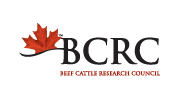Understanding Mycoplasma bovis pneumonia in beef cattle
| Project Code: | ANH.13.17 |
| Completed: | In Progress. Results expected in March 2021. |
Project Title:
Mycoplasma bovis pneumonia in beef cattle
Researchers:
Jeff Caswell D.V.M., D.V.Sc. Kent Fenton D.V.M. Jose Perez-Casal Ph.D. jcaswell@uoguelph.ca
Jeff Caswell D.V.M., D.V.Sc. (Ontario Veterinary College), Kent Fenton D.V.M. (Feedlot Health Management Services), Jose Perez-Casal Ph.D. (VIDO-InterVAC), Edouard Timsit D.V.M. (University of Calgary) and Ruud Veldhuizen Ph.D. (Western University)
Background:
Mycoplasma pneumonia and Bronchopneumonia with interstitial pneumonia (BIP) are costly diseases with performance losses, chronic illness and severe animal welfare impacts. Both diseases appear to be caused by Mycoplasma bovis (M. bovis). Efforts to prevent and treat mycoplasma pneumonia has significant antimicrobial use and resistance implications. These are challenging diseases to deal with because so little is known about how they develop. Even though calves commonly carry M. bovis, very few actually get sick. M. bovis may be more likely to cause disease if the calf’s lungs have already been damaged by Mannheimia hemolytica (shipping fever). M. bovis may also cause the calf’s immune system to degrade some lipids and proteins that are important for lung function.
Objectives:
To determine specifically how M. bovis causes damage to the lung and why M. bovis infection leads to pneumonia in some calves but not others. Researchers will also characterize BIP and identify the role of M. bovis as a cause of this newly emerged disease of feedlot cattle.
What They Will Do:
To determine how or whether M. bovis causes lung damage, lung lesions, lipase, phospholipase and protease levels will be compared between M. bovis pneumonia cases and healthy lungs. In addition, the effect of M. bovis exposure on lipase, protease, other proteins, or oxygen and nitrogen radical production by macrophages will be studied. These compounds will be exposed to immune and respiratory tract cells to see if lung surfactant breakdown, cell damage, or cell death occurs.
To determine the role of M. bovis infection in BIP, the team will describe the epidemiology and risk factors (prevalence, seasonality, year, feedlot, initial risk category, days on feed, ration, prior treatments, clinical course) by reviewing 500 previously recorded cases of the disease. They will compare samples from 20 BIP cases to 20 controls (other respiratory deaths) to characterize histopathology, immunohistochemistry, and the bacteria (including M. bovis) and viruses present. Surfactant samples will also be collected and compared to results obtained in the preceding step.
To determine the conditions for M. bovis infection and pneumonia, they will culture macrophages in conditions resembling an infected lung. Some macrophages will be infected with different strains of M. bovis and others won’t. Protease, lipase, and cytokine production will be compared. Then they will expose healthy M. bovis calves to M. haemolytica (with or without M. bovis). The M. haemolytica infections will be treated, and animal health, temperature, serum haptoglobin and fibrinogen, ultrasound, post-mortem lung lesions, bacterial culture, and histopathology will be observed. They will also impose inflammation and lung necrosis treatments on healthy calves and then expose them to M. bovis to see whether the severity of disease differs.
Implications:
This project will enhance our understanding of how M. bovis interacts with other respiratory pathogens to cause lung infection, damage and associated immune responses. This research will help inform continued efforts to develop an effective M. bovis vaccine and integrated disease prevention and treatment strategies, and ultimately support improved animal health and reduced reliance on antimicrobial interventions through reductions in bovine respiratory disease.








